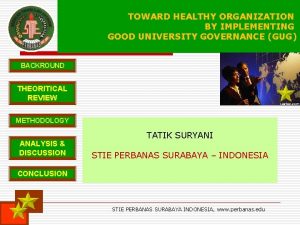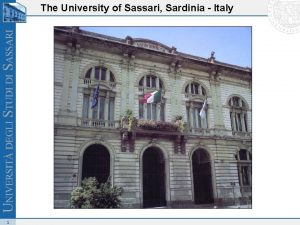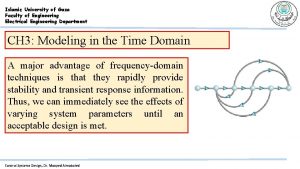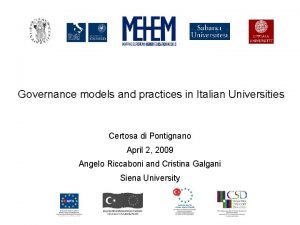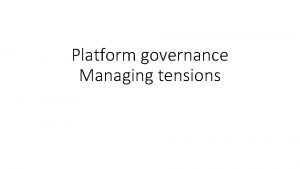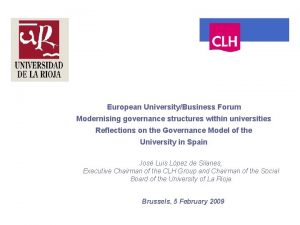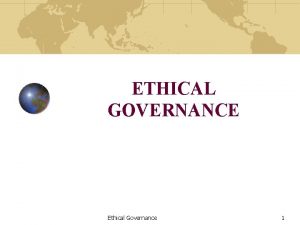Governance Models of European Universities and University Management



























- Slides: 27

Governance Models of European Universities and University Management & Development Strategies: - What works? By Professor Stephen Hagen Former Vice-Chancellor, University of Wales (Newport) Pro-Rector for Change Management ITMO University, St Petersburg 1

EUA’s Prague Declaration (2009) presented 10 success factors for European universities in the next decade, which included autonomy “Universities need strengthened autonomy to better serve society and specifically to ensure favourable regulatory frameworks which allow university leaders to design internal structures efficiently, select and train staff, shape academic programmes and use financial resources, all of these in line with their specific institutional missions and profiles”

EUA’s Lisbon Declaration (2007) sets out four basic dimensions of autonomy: q academic autonomy (deciding on degree supply, curriculum and methods of teaching, deciding on areas, scope, aims and methods of research); q financial autonomy (acquiring and allocating funding, deciding on tuition fees, accumulating surplus); q organisational autonomy (setting university structures and statutes, making contracts, electing decision-making bodies and persons); q staffing autonomy (responsibility for recruitment, salaries and promotions).

• Organisational autonomy Selection procedure for the executive head - Rector • • • Selection criteria for the executive head Rector • • Dismissal of the executive head Rector • Term of office of the executive • head - Rector Inclusion and selection of external members in governing • bodies • Capacity to decide on academic structures • • Capacity to create legal entities Ability to keep surplus • Length and type of public funding Ability to borrow money Ability to own buildings Academic autonomy Staffing autonomy • Financial autonomy Capacity to decide on recruitment procedures (senior academic/senior administrative staff) • • • Ability to charge tuition fees for national/EU students (BA, MA, • Ph. D) Ability to charge tuition fees for non-EU students (BA, MA, Ph. D) Capacity to decide on salaries (senior academic/ • senior administrative staff) Capacity to decide on • dismissals (senior academic/senior administrative staff) • • Capacity to decide on promotions (senior academic/senior administrative staff fourth line of text goes hre Capacity to decide on overall student numbers Capacity to select students (BA, MA) Capacity to introduce programmes (BA, MA, Ph. D) Capacity to terminate programmes Capacity to choose the language of instruction (BA, MA) • Capacity to select quality assurance mechanisms and providers • 4 Capacity to design content

Two Main types of Governance Structures Dual structure: Small Board (= strategic management) usually with external members + Senate (academic decisions) OR: Single ‘unitary’ decision-making Senate (rarely with external members) 5

Desirable Characteristics of a Governing Body q Members are appointed on merit and personal attributes q Are sympathetic to the ethos and objectives of universities q Represent a matrix of skills and experience most valuable to the University’s mission and strategy q Other important factors: § Regional/(inter)national balance § Equal opportunities balance (gender, age, ethnicity, disability, etc. )

Desirable Characteristics of a Governing Body q. Does its size matter (about 15 -25)? q. Leadership qualities in its chair and senior officers q. Understands the boundary between governance and management q. Has a majority of lay members but inclusive of academics and other members of the University

Selection of External Members in Governing Board q The inclusion and appointment of external members is an important aspect of a university’s governing structure. The selection can be carried out by the university itself and/or by an external authority. q The appointment of external members follows four main models: q Universities are free to appoint the external members of their governing bodies in Denmark, Estonia, Finland, Portugal and the United Kingdom. q External members are proposed by the institution, but appointed by an external authority in Norway, Slovakia and Sweden. q Some of the members are appointed by the university and some by an external authority in Austria, Cyprus, France, Hesse, Iceland Lithuania. q An external authority decides on the appointment in Hungary, Italy, Luxembourg, the Netherlands, Spain and Switzerland. 8

Case Study of Trends in University Governance q In Lithuania, the status of the governing bodies has changed with the passing of a new law in spring 2009. q Previously, the main decision-making body was the senate, while the council played a supervisory role. q Now the senate, which mainly comprises internal members, decides on academic issues and acts as a preparatory body for the council. q The Council is the main executive body. It comprises nine or eleven members, of which four or five are put forward by the ministry. q The university and the ministry also jointly decide on an additional – usually external – council member. § These examples reflect a trend towards more managerial universities with smaller decision- making bodies, into which external stakeholders have been integrated. 9

4 Methods of Selecting the Rector q. Elected by the governing body, which is democratically elected within the university community (usually the senate, i. e. the body deciding on academic issues) q. Appointed by the council/board of the university (i. e. the governing body deciding on strategic issues). q. Appointed through a two-step process in which both the senate and the council/board are involved q. Elected by a specific electoral body, which is usually large, representing (directly or indirectly) the different groups of the university community (academic staff, other staff, students), whose votes may be weighted.

LEGAL STATUS OF UNIVERSITIES Universities in 18 European countries can create companies: there can be financial and regulatory restrictions (NB Warwick in the UK has 4 trading companies) Some universities are ‘Foundation universities’; some are private companies; some are not-for-profit charities; sometimes external members are 40% of the Board More legal autonomy offers flexibility and income generation 11

Financial Autonomy q. Most universities receive annual funding from the Ministry in the form of a ‘block grant’ q. In such a framework, universities are free to divide and distribute their funding internally according to their needs, although some restrictions may apply. q. In France, Hungary, Iceland, Latvia, Lithuania, Portugal, Slovakia and Sweden, the block grant is divided into broad categories, such as teaching and research (Iceland, Sweden), teaching, research and infrastructure (Latvia, Lithuania), salaries and operational costs (Portugal), or investments, salaries and operational costs (France). q. As a rule, universities are unable to move funds between these categories. 12

Can Universities keep their surplus? 13

Levels of Financial Autonomy q. The capacity of universities to buy, sell and build facilities autonomously is closely linked to their freedom to determine their institutional strategy and academic profile. q In eight countries (CH, CY, EE, FR, GR, IS, LU, NO), institutions require the permission of an external authority, typically the ministry or parliament, to sell their real estate. 14

Levels of Financial Autonomy q. Can universities borrow money? 15

Setting Course Fees q With regard to tuition fees, the situation is highly complex. The various student populations – Bachelor, Master’s and doctoral as well as national/ EU and international students – are very different. q Fees are charged for national/EU students at Bachelor and Master’s level in a majority of systems. Only in very few systems may institutions freely set fees for Bachelor degrees. q In the rest, an external authority either determines fee levels unilaterally, sets an upper limit, or cooperates with institutions in setting student contributions. q Slightly more systems – eight – enable their universities to set fees at Master’s level. q The picture looks very different for international students. In 12 systems, universities can set fees independently at Bachelor level; in 13 systems, they can do so at Master’s level. q Recent reforms, particularly in some Northern European systems, have enabled universities to set fees for non-EU students. Universities are unable to charge fees at Bachelor and Master’s level in only six systems. 16

Who can charge student fees? 17

Trends in Student fees q. In a number of systems, there has been a noticeable move towards student contributions. q. Finland Sweden have taken steps to introduce fees for non- EU students. In Finland, this happened on a limited scale since 2010, namely for a number of Master’s programmes taught in foreign languages. q. In Sweden, fees for non-EU students were introduced in autumn 2011, which will be required to cover costs across the institution. q. In the UK, the ceiling for national/EU fee levels for undergraduate students was raised to 12. 600 euros per annum over four years ago 18

Student Numbers q A “cooperative” model involves negotiations between the university and the public authorities, which usually happens in one of two ways. q In 11 systems, student numbers are negotiated with the relevant ministry; this may q In 8 systems, institutions are free to decide on their student intake. Nonetheless, even in cases where universities can freely decide on student numbers, there may be specific limitations, such as nationally set requirements on the staff/student q There are ceilings for some fields, such as medicine, dentistry or engineering (as in Denmark or Sweden). q Even in free admission systems, such as France, the Netherlands or Switzerland, a numerus clausus may apply for these (and similar) fields. q Some institutions can take in additional students and they are able to charge fees 19

University staff and programmes q. In most systems, universities are not entirely free to set the salaries of their staff. A broad range of restrictions exists. q. In some countries civil servant status for university staff has been abolished or is being phased out, in many systems it still applies to at least some parts of university staff. q. In approximately a quarter of the countries, universities are able to open degree programmes without prior accreditation. In most of the remaining systems, universities require prior accreditation for programmes to be introduced or publicly funded 20

Appointments and Salaries q. In 22 systems (all but DK, ES, FR, GR, IE and PT), institutions are essentially free to decide on the recruitment of senior administrative staff. In the remainder, certain practices affect universities’ flexibility q. Universities in Europe are generally not entirely free to set the salaries of their academic or administrative staff members. q. Salaries for senior academic staff can be determined by universities in only four countries: the Czech Republic, Estonia, Sweden and Switzerland. q. In Latvia, the state sets a minimum salary for each staff category; however, this is largely equivalent to national labour regulations that set a minimum salary and is therefore not regarded as a restriction. 21

Recruitment practices for senior academic staff (Czech Republic, Finland, Sweden, France & Italy) q. Most university systems follow similar procedures. q. It is common practice to specify selection criteria at the Faculty level and to set up a selection committee to evaluate candidates. q. The successful applicant is subsequently appointed at Faculty level or, alternatively, by a decision-making body at university level. q. The selection committee either recommends one candidate or provides the decision-making body with a shortlist of preferred candidates in order of priority. 22

Quality Assurance q. Only in four countries (AT, CH, CY, IS) are universities able to select their quality assurance mechanisms freely and according to their needs. q. In Austria, universities make specific commitments concerning external quality assurance mechanisms, but these are mutually agreed upon in the context of their performance agreements. q. In the remaining 24 systems, institutions are unable to choose specific quality assurance mechanisms. Accreditation typically occurs on a programme basis, sometimes periodically. q. In Estonia, Finland, Ireland, Norway and the UK, quality assurance takes the form of institutional audits. q. Estonia is likely to base its list of eligible international quality assurance agencies on the European Quality Assurance Register 23

Trends q Many European universities have a new legal status which usually offers greater freedom from the state q In most European universities, external members now participate in the most important decisions q There is a noticeable shift towards smaller and more effective governing bodies, but very large governing bodies still exist in several systems, particularly in southern Europe q Most universities are free to decide on their internal academic structures and can create legal entities. In a number of cases, institutions can carry out certain additional activities more freely through such distinct legal entities q The Rector is always chosen by the institution itself. In half of the university systems, the selection (or election) needs to be confirmed by an external authority. This is a formality in many countries. 24

Trends, continued q. Financial autonomy is crucial for universities to achieve their strategic aims, which is why restrictions in this area are seen as particularly limiting. In almost all countries, universities receive their core public funding through block grants q. In over half the cases, universities can retain financial surpluses. q. Universities are now able to borrow money in a majority of systems, although various limitations still apply. For instance, they can either borrow only limited amounts or require external authorisation q. Universities can own real estate in the majority of the countries surveyed. Many do not own their buildings: they may be owned by public or private real estate companies 25

Summary q The United Kingdom leads the way in the area of organisational autonomy: its higher education system scores 100% on all indicators, meaning that higher education institutions can decide without state interference on all aspects encompassed by this area of autonomy. q An additional five systems – Denmark, Estonia, Finland, Ireland North Rhine-Westphalia - obtain scores higher than 80% and are thus included in the top cluster of highly autonomous systems. In those, universities may freely decide on the structure of their faculties and departments and create a variety of for-profit and not-for-profit legal entities. q In addition, all systems in the top cluster include external members in their governing bodies. In an upper tier of systems (DK, EE, FI), universities may freely appoint the external members of these bodies. q Ireland North Rhine-Westphalia, which form the bottom tier of the cluster, involve a local or state authority in the selection process. 26

Conclusions q Future reforms should focus on giving universities greater freedom in setting their own admission criteria. q It will also be crucial to find the right balance between autonomy and accountability by promoting independent institutional audits or evaluations of internal quality processes. q The key challenges of governance reforms lie in the practical implementation of regulations. q To implement legal reforms successfully, they need to be accompanied by support for institutional capacity-building and human resource development (HRD). q In order to make full use of greater institutional autonomy and to fulfil new tasks, additional management and leadership skills are needed. q Support to facilitate the acquisition of such skills is essential for successful governance reforms. 27
 University governance models
University governance models Nonprofit governance models
Nonprofit governance models Public sector governance models
Public sector governance models Semi modals
Semi modals Pearson
Pearson Fh
Fh Ufa state petroleum technical university
Ufa state petroleum technical university Chelyabinsk colleges and universities
Chelyabinsk colleges and universities Chon buri colleges and universities
Chon buri colleges and universities Yaroslavl state technical university
Yaroslavl state technical university Who's who in american colleges and universities
Who's who in american colleges and universities Mtcu thunder bay
Mtcu thunder bay Good university governance
Good university governance Good university governance
Good university governance Data governance and risk management
Data governance and risk management Hpe information management and governance
Hpe information management and governance Forrester grc wave 2015
Forrester grc wave 2015 D365 fo grc
D365 fo grc Slide to doc.com
Slide to doc.com Governance leadership and management
Governance leadership and management Oldest universities
Oldest universities Sura regional
Sura regional Ranking web of universities
Ranking web of universities Universities that offer pharmacy in nigeria
Universities that offer pharmacy in nigeria Universities that accept ged in pakistan
Universities that accept ged in pakistan Ontario universities' application centre founded
Ontario universities' application centre founded University of sassari
University of sassari Should universities departments engineering
Should universities departments engineering













